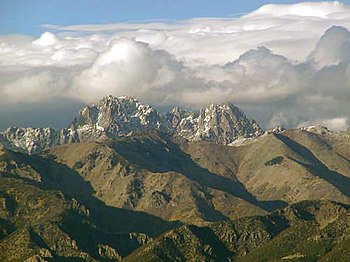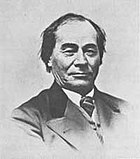The Colorado Portal


WikiProject Colorado
You need not be either an expert or a resident.
You only need an active interest in the Centennial State.
Request an article about a Colorado topic here or volunteer here.
Colorado Events
- Wikimedia US Mountain West Summer 2024 online meeting, Tuesday, August 13, 2024, 8:00-9:00 PM MDT
- Wikimedia US Mountain West Autumn 2024 online meeting, Tuesday, November 12, 2024, 8:00-9:00 PM MST
Previous events:
|
|---|
Colorado events
|
Colorado Facts
- Date admitted to Union: August 1, 1876 (38th State)
- Demonym: Coloradan
- Capital: Denver
- Elected state officers:
- Governor: Jared Polis (D) (2019–)
- Lieutenant Governor: Dianne Primavera (D) (2019–)
- Secretary of State: Jena Griswold (D) (2019–)
- Treasurer: Dave Young (D) (2019–)
- Attorney General: Phil Weiser (D) (2019–)
- Colorado General Assembly:
- Colorado Senate:
- D-23 R-12 (2023–2024}
- Colorado House of Representatives:
- D-46 R-19 (2023–2024}
- Colorado Senate:
- Colorado Supreme Court:
- Brian Boatright, Chief Justice (2021–)
- Monica Márquez (2010-)
- William Hood, III (2014–)
- Richard Gabriel (2015–)
- Melissa Hart (2017–)
- Carlos Samour, Jr (2018–)
- Maria Berkenkotter (2021–)
- U.S. Senators:
- Class 2. John Hickenlooper (D) (2021–)
- Class 3. Michael Bennet (D) (2009–)
- 1. Diana DeGette (D) (1997–)
- 2. Joe Neguse (D) (2019–)
- 3. Lauren Boebert (R) (2021–2025)
- 4. vacant
- 5. Doug Lamborn (R) (2007–2025)
- 6. Jason Crow (D) (2019–)
- 7. Brittany Pettersen (D) (2023-)
- 8. Yadira Caraveo (D) (2023–)
- Total area: 104,094 square miles (269,602 km2) (eighth most extensive state)
- Highest elevation: Mount Elbert 14,440 feet (4,401.2 m) (third highest state)
- Mean elevation: 6,800 feet (2,070 m) (highest state)
- Lowest elevation: Arikaree River 3,317 feet (1,011 m) (highest state)
- Population (2020 census): 5,773,714 (21st most populous state)
- Population density: 55.47 per square mile (21.40 km−2) (39th most densely populated state)
- Number of counties: 64 counties (including two consolidated city and county governments)
- Number of municipalities: 273 municipalities, comprising 2 consolidated city and county governments, 73 cities, and 198 towns
- Time zone: MST=UTC−07, MDT=UTC−06
- USPS code: CO
- ISO 3166 code: US-CO
- Adjacent U.S. states: Wyoming, Nebraska, Kansas, Oklahoma, New Mexico, Arizona, Utah (tied for third most)
- State government website: Colorado.gov
- State tourism website: Colorado.com
State Symbols
Subcategories
Interstate 70 (I-70) is a transcontinental Interstate Highway in the United States, stretching from Cove Fort, Utah, to Baltimore, Maryland. In Colorado, the highway traverses an east–west route across the center of the state. In western Colorado, the highway connects the metropolitan areas of Grand Junction and Denver via a route through the Rocky Mountains. In eastern Colorado, the highway crosses the Great Plains, connecting Denver with metropolitan areas in Kansas and Missouri. Bicycles and other non-motorized vehicles, normally prohibited on Interstate Highways, are allowed on those stretches of I-70 in the Rockies where no other through route exists.
The United States Department of Transportation (USDOT) lists the construction of I-70 among the engineering marvels undertaken in the Interstate Highway System and cites four major accomplishments: the section through the Dakota Hogback, Eisenhower Tunnel, Vail Pass, and Glenwood Canyon. The Eisenhower Tunnel, with a maximum elevation of 11,158 feet (3,401 m) and length of 1.7 miles (2.7 km), is the longest mountain tunnel and highest point along the Interstate Highway System. The portion through Glenwood Canyon was completed on October 14, 1992. This was one of the final pieces of the Interstate Highway System to open to traffic and is one of the most expensive rural highways per mile built in the country. The Colorado Department of Transportation (CDOT) earned the 1993 Outstanding Civil Engineering Achievement Award from the American Society of Civil Engineers for the completion of I-70 through the canyon. (Full article...)Selected mountain -
Selected biography -
In 1835 Bent married Owl Woman, the daughter of White Thunder, a Cheyenne chief and medicine man. Together they had four children. Bent was accepted into the Cheyenne tribe and became a sub-chief. In the 1840s, according to the Cheyenne custom for successful men, Bent took Owl Woman's sisters, Eagle Woman and Island, as secondary wives. He had his fifth child with Eagle Woman. After Owl Woman died in 1847, Island cared for her children. Each of the sisters left Bent and, in 1869, he married the young Adaline Harvey, the educated mixed-race daughter of Alexander Harvey, a friend who was a prominent American fur trader in Kansas City, Missouri. Bent died shortly after their marriage, and Adaline bore their daughter, his sixth child, after his death. (Full article...)
Selected article -
Malcolm Scott Carpenter (May 1, 1925 – October 10, 2013) was an American naval officer and aviator, test pilot, aeronautical engineer, astronaut and aquanaut. He was one of the Mercury Seven astronauts selected for NASA's Project Mercury in April 1959. Carpenter was the second American (after John Glenn) to orbit the Earth and the fourth American in space, after Alan Shepard, Gus Grissom and Glenn.
Commissioned into the U.S. Navy in 1949, Carpenter became a naval aviator, flying a Lockheed P-2 Neptune with Patrol Squadron 6 (VP-6) on reconnaissance and anti-submarine warfare missions along the coasts of Soviet Union and China during the Korean War and the Cold War. In 1954, he attended the U.S. Naval Test Pilot School at NAS Patuxent River, Maryland, and became a test pilot. In 1958, he was named Air Intelligence Officer of USS Hornet, which was then in dry dock at the Bremerton Navy Yard. (Full article...)Selected image -
A painting by Albert Bierstadt, 1876
National Parks in Colorado
The 23 national parks in Colorado:
- Amache National Historic Site
- Arapaho National Recreation Area
- Bent's Old Fort National Historic Site
- Black Canyon of the Gunnison National Park
- Browns Canyon National Monument
- Camp Hale-Continental Divide National Monument
- Canyons of the Ancients National Monument
- Chimney Rock National Monument
- Colorado National Monument
- Continental Divide National Scenic Trail
- Curecanti National Recreation Area
- Dinosaur National Monument
- Florissant Fossil Beds National Monument
- Great Sand Dunes National Park and Preserve
- Hovenweep National Monument
- Mesa Verde National Park and World Heritage Site
- Old Spanish National Historic Trail
- Pony Express National Historic Trail
- Rocky Mountain National Park
- Sand Creek Massacre National Historic Site
- Santa Fe National Historic Trail
- Yucca House National Monument
Interesting facts-

- The world's largest brewery is located in Golden.
- Byron White was the only All-American football player to sit on the Supreme Court of the United States (1962-1993).
- Ben Nighthorse Campbell was only the second Native American to sit in the United States Senate (1993-2005).
- The lowest point in Colorado is higher than the highest point of 18 U.S. states.
- Colorado had a 2014 life expectancy of 80.21 years, longest of any U.S. state.
- Colorado has the lowest rate of heart disease of any U.S. state (2.7% – USCB 2008)
- Colorado has the lowest rate of adult obesity of any U.S. state (20.5% – CDC 2012)
- Colorado has the fewest motor vehicles per capita of any U.S. state (0.328 – USCB 2008)
Did you know (auto-generated) -

- ... that the 1976 Big Thompson River flood took place several hours before Colorado's 100th anniversary of statehood?
- ... that some members of the Daughters of the American Revolution came up with the idea to design a flag of Colorado, unaware that such a flag already existed?
- ... that "The Potato King of Colorado" survived a shipwreck, mined for gold in Australia, and helped establish an alcohol-free Methodist colony?
- ... that Charles Johnson received the most votes for student body president at the University of Colorado Boulder, even though he had already been disqualified from running?
- ... that Yemi Mobolade is the first Black person and the first non-Republican to be elected the mayor of Colorado Springs, Colorado?
- ... that Parkville lost out on becoming the Colorado Territory's capital by eleven votes and is now a ghost town largely buried under mining waste?
- ... that Aymara legislator Rafael Quispe's humorous style of political activism led one Bolivian parliamentarian to describe him as the "Chapulín Colorado" of the Legislative Assembly?
Related WikiProjects
Related portals
Resources
Associated Wikimedia
The following Wikimedia Foundation sister projects provide more on this subject:
-
Commons
Free media repository -
Wikibooks
Free textbooks and manuals -
Wikidata
Free knowledge base -
Wikinews
Free-content news -
Wikiquote
Collection of quotations -
Wikisource
Free-content library -
Wikiversity
Free learning tools -
Wikivoyage
Free travel guide -
Wiktionary
Dictionary and thesaurus






















